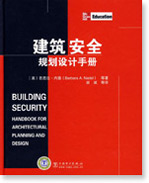BUILDING SECURITY: HANDBOOK FOR ARCHITECTURAL PLANNING AND DESIGN
Barbara A. Nadel, FAIA, Editor-in-Chief
McGraw-Hill, 2004
ISBN: 0-07-141171-2 / $99.95 / HARDCOVER
672 pages / 600 illustrations
Building Security: Creating Safe and Secure Environments
Whether planning for new construction, renovations, or security upgrades of existing facilities, Building Security: Handbook for Architectural Planning and Design is the definitive twenty-first century reference on security design, technology, building operations, and disaster planning. Award-winning architect and author Barbara A. Nadel, FAIA, provides security design solutions for creating safe commercial, institutional, industrial, and residential buildings in the post-September 11, 2001 environment.
Building Security addresses over 20 building types, engineering, codes, disaster planning and response, and lessons learned from past disasters. Generously illustrated with 600 photos, drawings, tables, and checklists, this comprehensive compendium addresses protection from terrorism, natural disasters, chemical and biological agents, crime, and workplace violence.
- Provides one-stop reference on security planning, design, technology, building operations, disaster response, recovery, and crisis management.
- Includes more than 50 expert contributors from over 30 professional firms, public agencies, and nonprofit organizations across the United States.
The Building Security Second Edition is underway, with chapter updates, new chapters, and contributors.
Download Building Security Chapter 1 (PDF)
TABLE OF CONTENTS
Foreword by Amb. Richard N. Swett, FAIA
Part 1: Achieving Transparent Security
Chapter 1: Lessons Learned from September 11, 2001 and other Benchmark Events (Barbara A. Nadel, FAIA)
Chapter 2: Security Master Planning (David Thompson, AIA and Bill McCarthy, AIA)
Chapter 3: Crime Prevention Through Environmental Design (Terri Kelly)
Part 2: Planning & Design
Chapter 4: Arenas, Sports Facilities, Convention Centers, Performing Arts Facilities: Safety and Security after September 11, 2001 (Russ Simmons, Gerald Anderson, AIA, and the International Association of Assembly Managers, Safety and Security Task Force)
Chapter 5: Commercial High-Rise Egress Systems (Carl Galioto, FAIA)
Chapter 6: Courthouse Security (Kenneth J. Jandura, AIA, and David R. Campbell, PE)
Chapter 7: Federally Owned or Leased Office Buildings: Security Design (Terry Leach, AIA)
Chapter 8: Health Care Security (Thomas M. Jung, R.A.)
Chapter 9: Historic Preservation Guidance for Security Design (Sharon C. Park, FAIA and Caroline R. Alderson)
Chapter 10: Hospitality Facility Security (Bradley D. Schulz, AIA)
Chapter 11: Multifamily Housing: Security Checklist for Building Owners and Real Estate Professionals (James W. Harris)
Chapter 12: Home and Business Security, Disaster Planning, Response and Recovery (Barbara A. Nadel, FAIA)
Chapter 13: Industrial Facilities and Office Buildings: Safety, Security, Site Selection and Workplace Violence (Barbara A. Nadel, FAIA)
Chapter 14: Lobby Security Design: First Impressions (Casey L. Jones)
Chapter 15: Museum and Cultural Facility Security (Arthur Rosenblatt, FAIA)
Chapter 16: Perimeter Security: The Aesthetics of Protection (Deborah Bershad and Jean Parker Phifer, FAIA)
Chapter 17: Religious Institutions and Community Centers (Anti-Defamation League)
Chapter 18: Research Facilities: Security Planning (Regis Gaughan, PE, Joseph Calabrese, PE, and Stanley Stark, FAIA)
Chapter 19: Retail Security Design (Jeffrey J. Gunning, AIA, and Lance K. Josal, FAIA)
Chapter 20: School Security: Designing Safe Learning Environments (Thomas Blurock, FAIA)
Chapter 21: Women's Health Centers: Workplace Safety and Security (Barbara A. Nadel, FAIA)
Part 3: Engineering
Chapter 22: Protective Design of Structures (Richard L. Tomasetti, PE, Hon. AIA, and John Abruzzo, PE)
Chapter 23: Mechanical, Electrical, Fire Protection Design (Andrew Hlushko, PE)
Chapter 24: Chemical and Biological Protection (Michael C. Janus, PE, and William K. Blewett)
Part 4: Construction
Chapter 25: Construction Cost Estimating for Security- Related Projects (Elizabeth J. Heider, AIA)
Chapter 26: Construction: Emergency Response - Lessons Learned from September 11, 2001 (Lewis J. Mintzer)
Part 5: Technology And Materials
Chapter 27: Security Technology (William G. Sewell, RCDD)
Chapter 28: Selecting and Specifying Security Technology Products: A Primer for Building Owners and Facility Managers (Francis J. Sheridan, AIA)
Chapter 29: Glazing and Security Glass Applications (F. John W. Bush, Sue Steinberg, and Catherine Kaliniak)
Part 6: Codes And Liabilities
Chapter 30: Codes, Standards, and Guidelines for Security Planning and Design (Walter "Skip" Adams, CPP, and Deborah A. Somers)
Chapter 31: Liability Exposure After September 11, 2001 (Michael S. Zetlin, Esq., and Noelle Lilien, Esq.)
|

"The first place architects and security practitioners should go to for security design."
– Former Security and Safety Director, Major International Organization
"The last word in security design."
– AIArchitect

|

